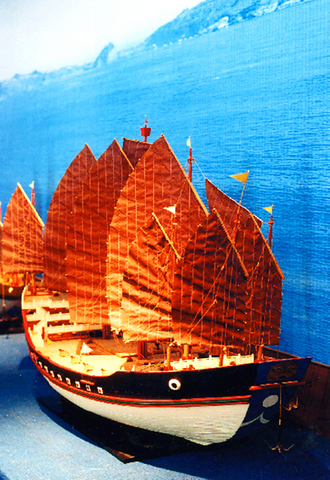Earlier this year magazines and television networks were awash with articles and programs celebrating the 600th anniversary of the first voyage of China's greatest maritime explorer, Zheng He (
Both Time and the National Geographic magazines published lengthy articles about the famed eunuch admiral and Life magazine even went as far as to rank him as the 14th most important person of the last millennium.
While it might have taken the National Museum of History (

PHOTO COURTESY OF THE NATIONAL MUSEUM OF HISTORY
Having reportedly spent two years preparing for the exhibition, one would have thought that the museum's historians and curators would have had ample time to create a wonderfully in-depth and entertaining display packed with a wide range of exhibits and information. Sadly, however, the exhibition is one of the most shoddily organized exhibits the museum has ever put together.
It might boast over 200 artifacts, but it gives visitors only a fleeting glimpse of the exploits of China's famed maritime explorer and even less of an insight into the man himself. It's safe to assume that long deceased admiral would be turning in his grave if could see the way in which the museum has set about telling his story in an overly simplified and boring manner.
The first area deals with historical facts. The crux of this section is, however, overshadowed by the inclusion of a dozen replica boats. The models are colorful, well made and look fantastic and the information about each boat is enough to satisfy the appetites of most amateur historians. For example, we learn that the fleet consisted of 30,000 men and 300 ships, which included everything from huge treasure ships to smaller patrol boats and water tankers.
The second part proves a bigger disappointment than the first. Here visitors get to see how China's navy of the day navigated its way from China through the Indian Ocean to what is today the Saudi Arabian peninsular and Africa. It's pretty mundane stuff and unless you happen to be a 12-year-old school kid there's very little to learn here. Here visitors can also see a display of models of generic 15th century Chinese junks that were made in Belgium at the turn of the 20th century. Quite what these models have to do with Zheng He is anybody's guess and, while interesting to look at, they don't boast the same charm as those in the exhibition's first section.
The final part of the exhibition deals with artifacts from several of Zheng He's ports of call. There are over 100 porcelain, wood and pottery objects on display and they range from African tribal statuettes to Malayan tableware of the period.
The exhibition's most intellectually stimulating exhibit is a hand drawn Ming dynasty map (1368 to 1644) which plots Zheng He's travels from his base in the Yangze River delta through South East Asia. The map makes for an interesting few minutes for those with an understanding of Chinese characters. A more recent map published by China's nav allows visitors to plot Zheng He's course on a modern map and makes for equally engrossing viewing.
With the exception of the aforementioned maps the exhibition has little to offer anyone with prior knowledge of Zheng He's voyages and the exhibit makes the story of the Yunnan-born admiral appear like a passing footnote in history.
There are a couple of English language explanations of Zheng He's journeys, but they are pretty basic and as is all too often the norm with exhibitions at the National Museum of History, if you haven't got time for a tour and can't read Chinese then there's little point in going.

Taiwan is one of the world’s greatest per-capita consumers of seafood. Whereas the average human is thought to eat around 20kg of seafood per year, each Taiwanese gets through 27kg to 35kg of ocean delicacies annually, depending on which source you find most credible. Given the ubiquity of dishes like oyster omelet (蚵仔煎) and milkfish soup (虱目魚湯), the higher estimate may well be correct. By global standards, let alone local consumption patterns, I’m not much of a seafood fan. It’s not just a matter of taste, although that’s part of it. What I’ve read about the environmental impact of the

It is jarring how differently Taiwan’s politics is portrayed in the international press compared to the local Chinese-language press. Viewed from abroad, Taiwan is seen as a geopolitical hotspot, or “The Most Dangerous Place on Earth,” as the Economist once blazoned across their cover. Meanwhile, tasked with facing down those existential threats, Taiwan’s leaders are dying their hair pink. These include former president Tsai Ing-wen (蔡英文), Vice President Hsiao Bi-khim (蕭美琴) and Kaohsiung Mayor Chen Chi-mai (陳其邁), among others. They are demonstrating what big fans they are of South Korean K-pop sensations Blackpink ahead of their concerts this weekend in Kaohsiung.

The captain of the giant Royal Navy battleship called his officers together to give them a first morsel of one of World War II’s most closely guarded secrets: Prepare yourselves, he said, for “an extremely important task.” “Speculations abound,” one of the officers wrote in his diary that day — June 2, 1944. “Some say a second front, some say we are to escort the Soviets, or doing something else around Iceland. No one is allowed ashore.” The secret was D-Day — the June 6, 1944, invasion of Nazi-occupied France with the world’s largest-ever sea, land and air armada. It punctured Adolf

The first Monopoly set I ever owned was the one everyone had — the classic edition with Mr Monopoly on the box. I bought it as a souvenir on holiday in my 30s. Twenty-five years later, I’ve got thousands of boxes stacked away in a warehouse, four Guinness World Records and have made several TV appearances. When Guinness visited my warehouse last year, they spent a whole day counting my collection. By the end, they confirmed I had 4,379 different sets. That was the fourth time I’d broken the record. There are many variants of Monopoly, and countries and businesses are constantly